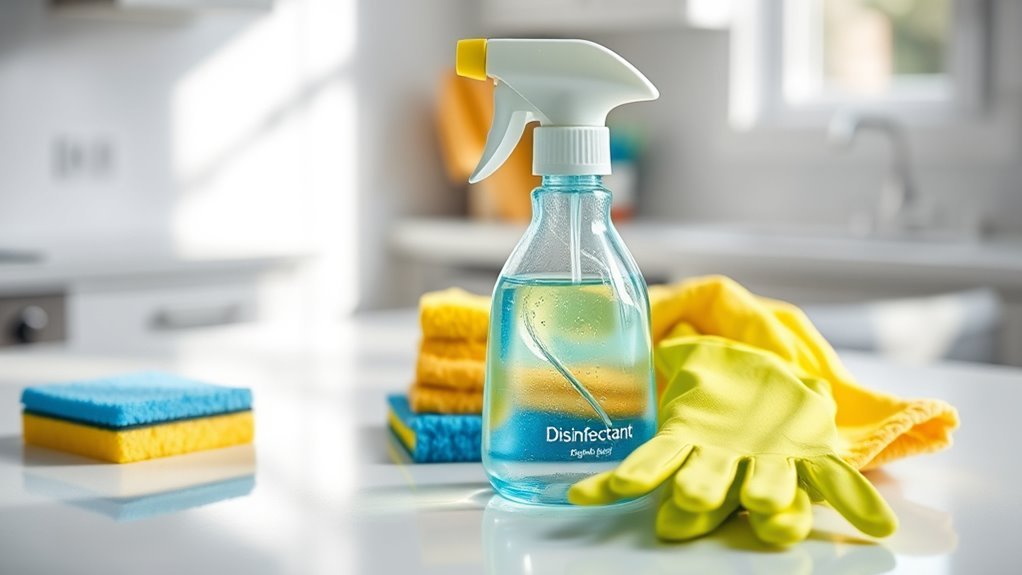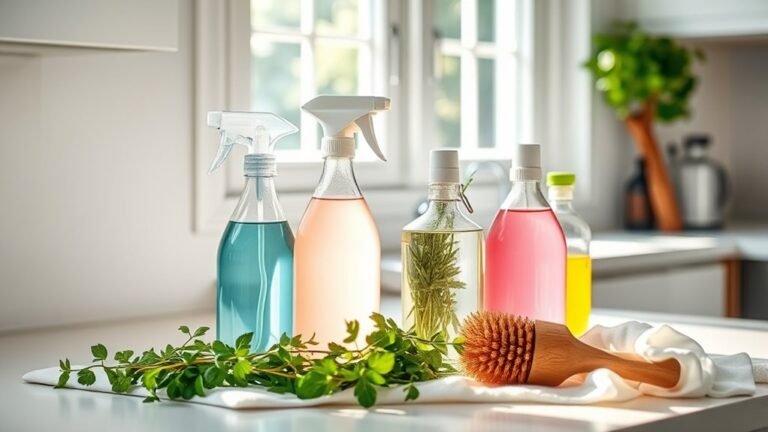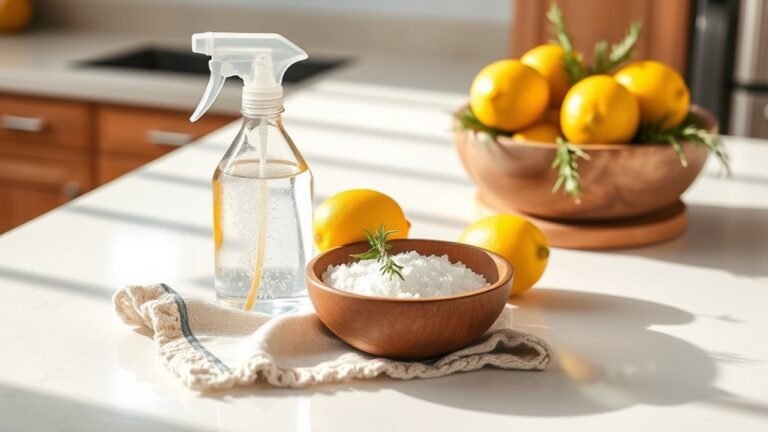Seasonal Maintenance Tips for Germs
You should adjust your cleaning routine with the seasons to fight germs better. Clean high-touch spots like doorknobs and switches often. Manage indoor humidity between 30-50% to stop mold and bacteria growth. Use disinfectants suited for the season’s common germs, and keep your HVAC system maintained for fresh, germ-free air. Proper ventilation also plays a big role. Following these tips can help you maintain a healthier home environment all year long—there’s plenty more to explore for each season’s needs.
Adjust Cleaning Frequency Based on Season
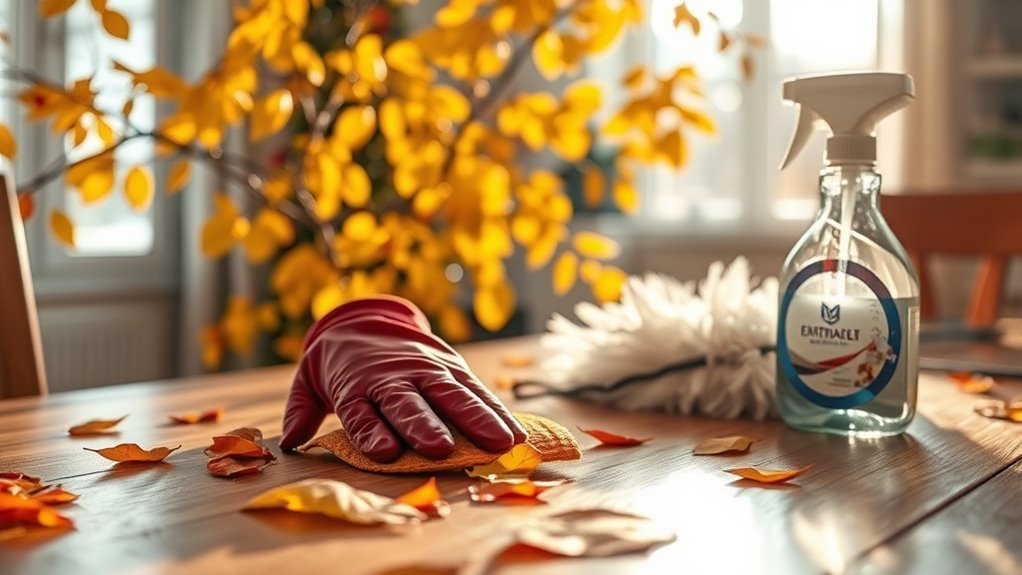
Although you might keep a regular cleaning schedule year-round, adjusting how often you clean based on the season can better control germs. When winter hits, germs spread more easily indoors, so increasing cleaning frequency helps keep your space fresh and healthy. In contrast, summer’s warmth encourages allergies and mold, so focusing on areas prone to moisture is key. Spring and fall bring their own challenges, like pollen or dust buildup, which you should tackle promptly. Using these seasonal tips lets you tailor your cleaning schedules without feeling tied down, giving you more freedom to enjoy life. By adapting your routine with the seasons, you stay ahead of germs efficiently and effortlessly, maintaining a healthier environment all year long.
Focus on High-Touch Surfaces
You’ll want to pay extra attention to high-touch surfaces like doorknobs, light switches, and remote controls, as these spots tend to harbor the most germs. Using effective cleaning techniques, such as disinfecting wipes or sprays with EPA-approved ingredients, can make a big difference. Regularly targeting these areas helps reduce the spread of germs throughout your home.
Identify Common Touchpoints
When you think about keeping your space germ-free, the first step is to pinpoint the areas you touch most often. These germ hotspots are where germs gather quickly, so knowing them helps you target surface sanitization efficiently. Focus on places you and others frequently interact with daily. Here are common touchpoints to watch out for:
- Door handles and knobs
- Light switches
- Remote controls and keyboards
- Faucet handles
Effective Cleaning Techniques
Knowing where germs tend to gather is only part of the battle; how you clean those high-touch surfaces makes all the difference. You want to focus on deep cleaning areas like door handles, light switches, and countertops regularly. Choose eco friendly products that are tough on germs but gentle on your health and the environment. These products help you maintain a clean space without sacrificing your values. Use microfiber cloths and a good scrubbing technique to lift dirt and microbes effectively. Remember, wiping alone isn’t enough—you need to let disinfectants sit for the recommended time to truly kill germs. By adopting these effective cleaning techniques, you gain control over your environment and maintain the freedom to live confidently, knowing your space is safer.
Manage Indoor Humidity Levels

Although managing indoor humidity might seem minor, it plays an essential role in controlling germs during seasonal changes. You want to maintain the right moisture balance to prevent mold and bacteria from thriving. Here’s how you can do it without feeling restricted:
- Adjust your dehumidifier settings to keep humidity between 30-50% for ideal comfort and germ control.
- Use exhaust fans in bathrooms and kitchens to reduce excess moisture.
- Open windows when weather allows, giving your home fresh air and reducing stuffiness.
- Check for leaks or damp spots that can raise humidity and encourage germs.
Use Seasonal-Appropriate Disinfectants
Controlling humidity sets the stage for effective germ management, but it’s only part of the equation. You’ll want to focus on disinfectant selection next, choosing products that match the season’s demands. Different times of the year bring unique challenges—winter may require disinfectants with ingredients targeting cold-weather viruses, while summer calls for formulations effective against heat-loving bacteria. Seasonal ingredients in your disinfectants can boost their power and reduce unnecessary chemical exposure, letting you keep your space safe without feeling trapped by harsh smells or residues. By adapting your disinfectant choices to the season, you maintain a healthier environment and gain freedom from persistent germs year-round, all without overusing products that don’t fit the current conditions.
Maintain HVAC Systems Regularly
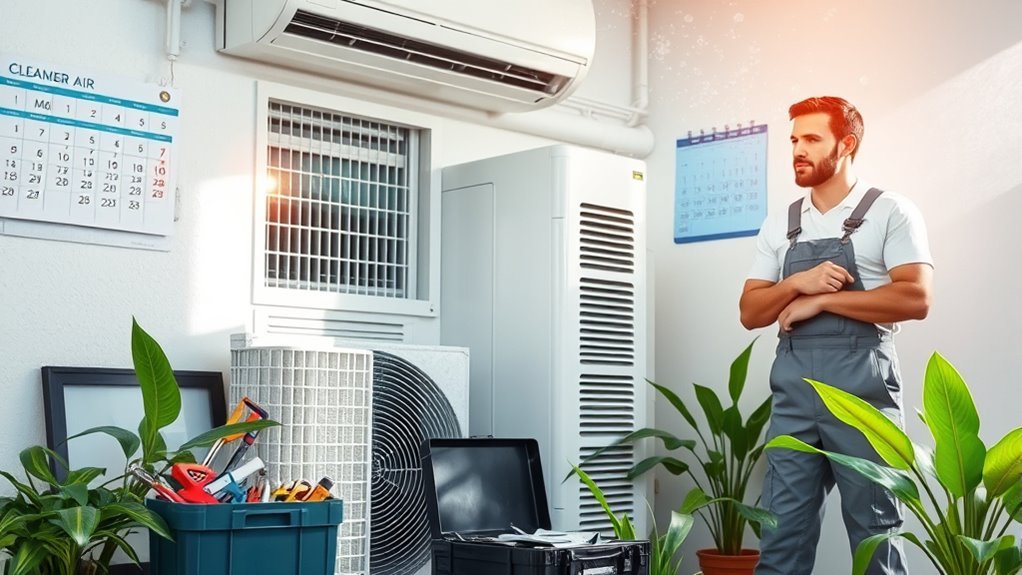
Since your HVAC system plays a critical role in circulating air and controlling indoor humidity, maintaining it regularly is crucial for effective germ management. To keep your space fresh and free from unwanted germs, make certain you:
Regular HVAC maintenance is essential for controlling indoor humidity and managing germs effectively.
- Schedule routine system inspection to catch issues early and guarantee peak performance.
- Perform timely filter replacement to trap dust, allergens, and germs efficiently.
- Clean vents and ducts to prevent germ buildup and improve airflow.
- Monitor humidity levels to discourage mold and bacteria growth inside the system.
Implement Proper Ventilation Practices
You’ll want to optimize airflow by using fans and opening windows when possible. Keeping humidity levels in check helps prevent germ growth and keeps the air fresh. Don’t forget to maintain your ventilation system regularly to guarantee it’s working efficiently.
Airflow Optimization Techniques
Proper ventilation is one of the simplest ways to keep germs from spreading in your home. When you understand airflow dynamics, you can optimize air quality and create a healthier space with ease. To get started, focus on these key airflow optimization techniques:
- Open windows and doors regularly to promote natural air exchange.
- Use fans strategically to direct airflow and prevent stagnant air pockets.
- Keep air vents and filters clean to guarantee efficient circulation.
- Arrange furniture to avoid blocking airflow pathways.
Humidity Control Methods
Although ventilation plays a crucial role in reducing germs, controlling humidity levels is just as important for maintaining a healthy environment. You don’t have to sacrifice comfort or freedom when managing moisture in your space. Exploring dehumidifier options gives you control over excess humidity, preventing mold and bacteria growth. Look for models with built-in humidity sensors—they automatically adjust settings to keep levels ideal without constant monitoring. This means you can enjoy fresh air without worry, knowing your environment discourages germs from thriving. By implementing these smart humidity control methods, you maintain a cleaner, healthier space effortlessly. Taking charge of your indoor climate empowers you to create a safe haven that supports your well-being without limits or hassle.
Ventilation System Maintenance
Since ventilation systems play a key role in keeping germs at bay, maintaining them regularly is essential for a healthy indoor environment. You want to guarantee your space breathes freely, reducing the risk of airborne germs. Different ventilation types—natural, mechanical, or hybrid—need your attention to work effectively.
Here’s how you can keep things fresh and germ-free:
- Check and replace air filters every 1-3 months to trap dust and pathogens.
- Clean vents and ducts to prevent buildup that can harbor germs.
- Guarantee fans and exhaust systems run smoothly for proper airflow.
- Use a mix of ventilation types when possible to maximize fresh air exchange.
Frequently Asked Questions
How Do Seasonal Allergies Affect Germ Growth in the Home?
Think of your home as a battlefield where pollen exposure sparks your immune response like a sudden storm. When your immune system kicks into high gear because of allergies, it can unintentionally create a warmer, more humid environment—perfect for germ growth. You might not realize it, but that sneeze or sniffle signals changes inside your space, giving germs a chance to thrive. So, staying vigilant can help you keep your freedom from illness intact.
Can Houseplants Help Reduce Germs Seasonally?
You might be surprised, but houseplants can actually help reduce germs seasonally by improving indoor air quality. Their natural houseplant benefits include filtering out toxins and boosting humidity, which creates an environment less friendly to germs. Plus, having greenery around can make your living space feel fresher and more inviting. So, if you want a healthier home and a touch of nature, adding some houseplants is a smart, freeing choice.
What Role Does Sunlight Play in Killing Germs Indoors?
Did you know that UV radiation from sunlight can kill up to 99.9% of certain bacteria on surfaces? When you let sunlight exposure flood your indoor spaces, you’re not just brightening things up—you’re harnessing a natural, powerful germ fighter. This means you can enjoy cleaner air and surfaces without harsh chemicals, giving you the freedom to live healthier and more naturally. So, open those blinds and let the sunshine do its work!
Are There Natural Alternatives to Chemical Disinfectants for Seasonal Use?
You don’t have to rely solely on chemical disinfectants; natural disinfectants like vinegar and hydrogen peroxide are great alternatives. Essential oils, such as tea tree, eucalyptus, and lavender, not only smell amazing but also have antimicrobial properties that help keep germs at bay. Using these natural options lets you maintain a cleaner space while feeling free from harsh chemicals, aligning perfectly with a lifestyle that values health and freedom.
How Does Seasonal Diet Impact the Body’s Ability to Fight Germs?
Your seasonal diet plays a big role in immune boosting because seasonal foods are packed with nutrients your body needs to fight germs. When you eat what’s naturally available during each season, you get a variety of vitamins and antioxidants that support your immune system. Plus, choosing local, seasonal foods helps you feel more connected and free to enjoy nature’s rhythms while staying healthy and resilient against illnesses.
